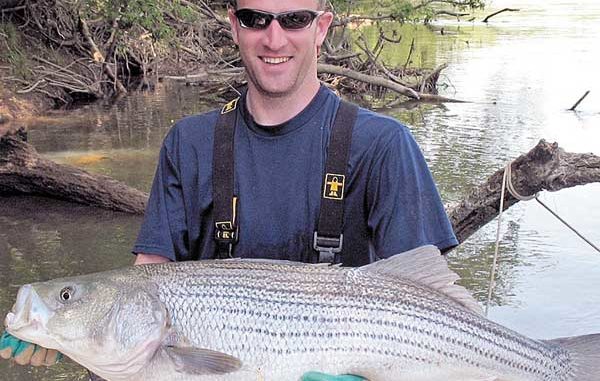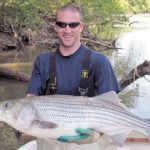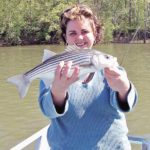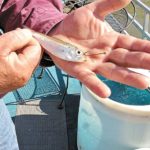
Roanoke River stripers wake up this sleepy town in April.
Shortly after sliding his boat in behind a big boil and setting up for a drift down the river, Mike Shearin gave the command to bait up and go fishing.Before the momentum had subsided, John Simeon dipped a net into the bubbling baitwell and came up with a collection of squirming shad minnows for everyone to use.
“There is a big rock just upcurrent from that big boil,” Shearin said. “The stripers will sometimes lay right behind it to rest a little before heading on up the river. They will also rest here and eat whatever is swept by in the current. Let’s gets some baits over and see if they are here this morning.”
The barbs on the Eagle Claw Series 42 hooks, flattened to conform to regulations, slid easily through the noses of the baits. Light egg sinkers on Carolina rigs carried them to the bottom, where they would intercept striped bass migrating up the Roanoke River.
It wasn’t long before the first, “Got him on,” cry rang out. Shortly after that first strike, another rod bent over double, and the action began. Soon, everybody had caught fish, and more were coming.
Any day is a good day to go fishing, but the day after income-tax deadline is especially nice, particularly if your accountant found a refund you weren’t expecting. Add to that a rockfish seminar presented by North Carolina Sportsman the previous evening at Halifax Community College, and all the stars appeared to aligned correctly — even if seminar speakers George Beckwith and Lee Parsons of Down East Guide Service had cautioned that it was early in the spring run and numbers of fish might not be great.
While the bite wasn’t as frenzied as it might be at the peak of the spawning run, either the timing was right or it was just a lucky day. However it turned out, it was good. Rarely did more than a few minutes pass without someone having a fish on.
Shearin, assistant recreation director for the town of Roanoke Rapids, is not a full-time guide, but he likes the Roanoke River, takes some time off each spring for the striped bass or “rockfish” run, and enjoys taking kids, families and first-timers out — specializing in them rather than hard-core fishermen. On board was one first-timer: Christina Gordon, the eco-tourism director for Halifax County.
Shearin uses a large pontoon boat as his fishing platform. Although more designed for the calmer waters of Roanoke Rapids Lake upstream, the boat was extremely stable, even with four people standing along the rail on the same side, and it easily handled the current eddies. It allowed for easy movement when baiting up or fighting a fish, especially when having to do the “rockfish roundabout” over or under another line. The relaxation of taking a short rest on the padded couch while running back up the river for another drift was also an unexpected comfort.
Shearin supplied a mixture of medium and medium-light spinning outfits. His rig of choice was a simple Carolina rig and Eagle Claw Series 42 wide-bend hooks — with the barbs flattened to the shank. Shearin’s instructions were to set the hook as soon as we felt anything, and only one fish caught all day was hooked deeply.
When a fish was brought to the boat, it was eased into a large tub, where the hook could be removed injuring the fish. The action wasn’t mid-run hot, but every drift produced several fish.
“We’re still several weeks from when the run usually peaks,” Shearin said. “The fishing will get better. There is a good group of boats on the river today, but this isn’t half of the crowd on a weekend. On weekends, those folks arriving late might have to wait more than an hour to launch or retrieve their boat. When my brother bought his place on the river and said I could tie up there, I was ecstatic — maybe even happier than him. Needless to say, I take him fishing whenever he wants to go.”
Most of the fish boated were between 16 and 18 inches long, well under the 22- to 27-inch slot limit. A few 20-inch fish were kept for dinner, but there’s no telling how many were released. The day’s catch was somewhere between 80 and 120 fish.
If that wasn’t the peak of the run, it was enough to leave fishermen wondering how tired they might be if the rockfish were even more cooperative.







Be the first to comment